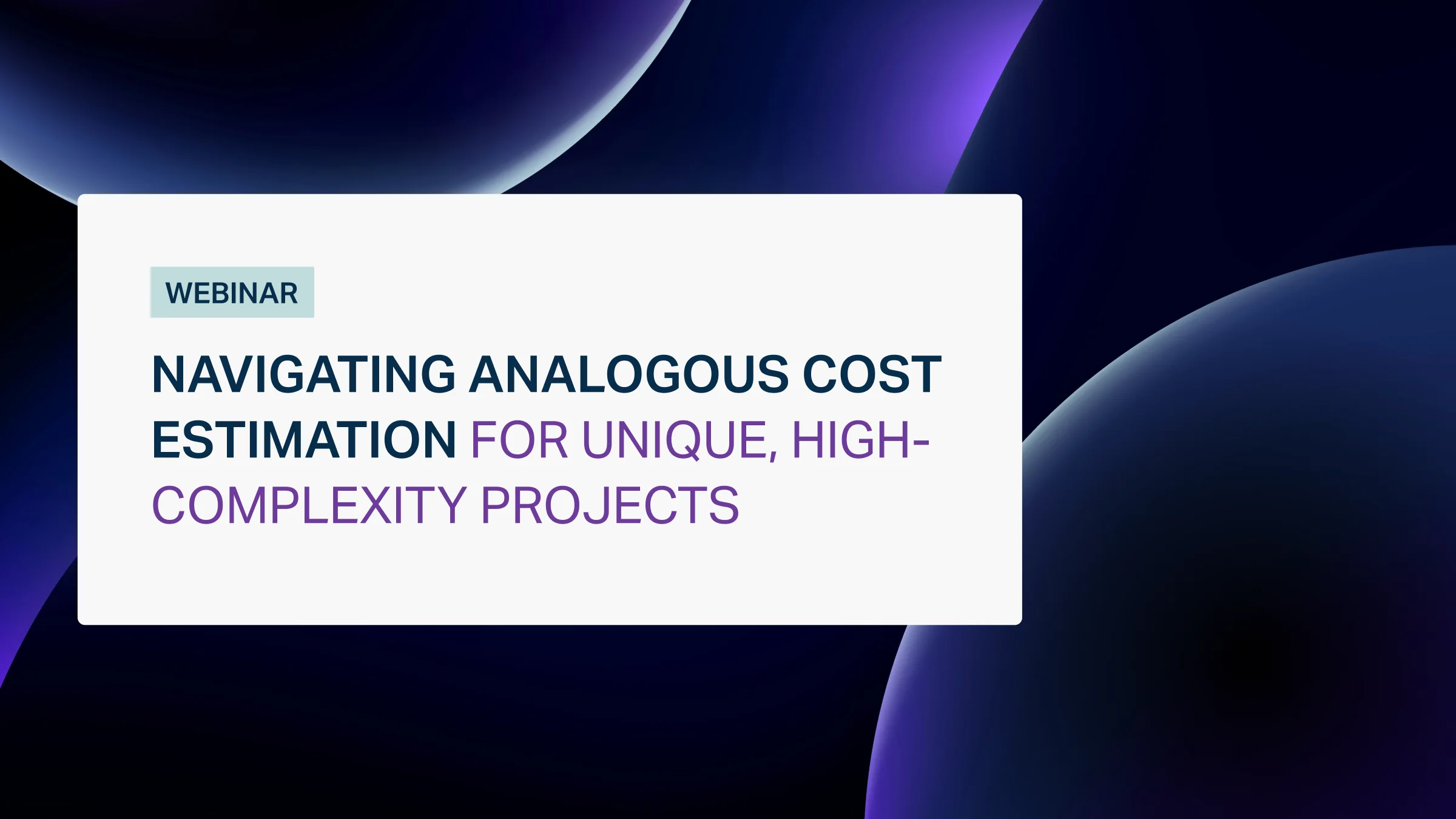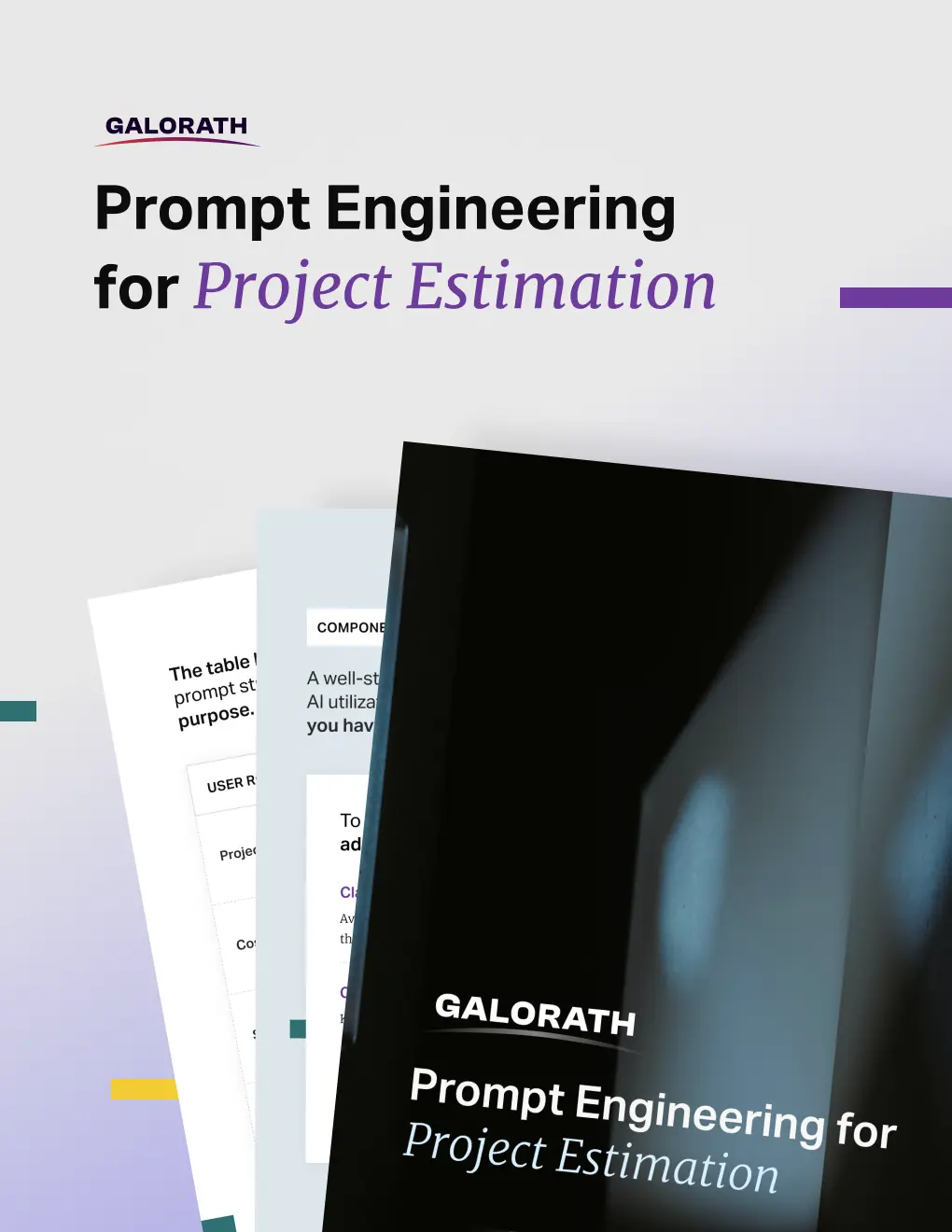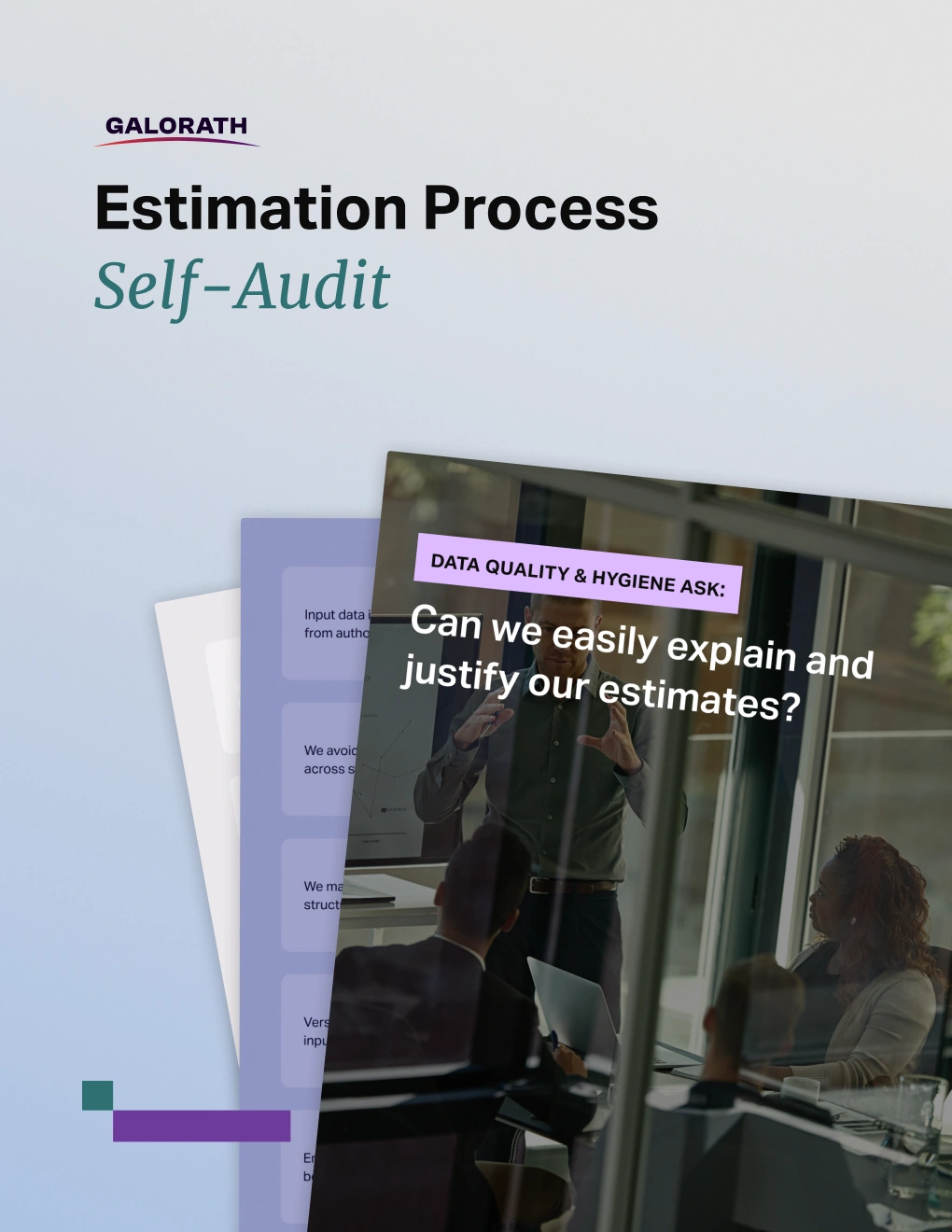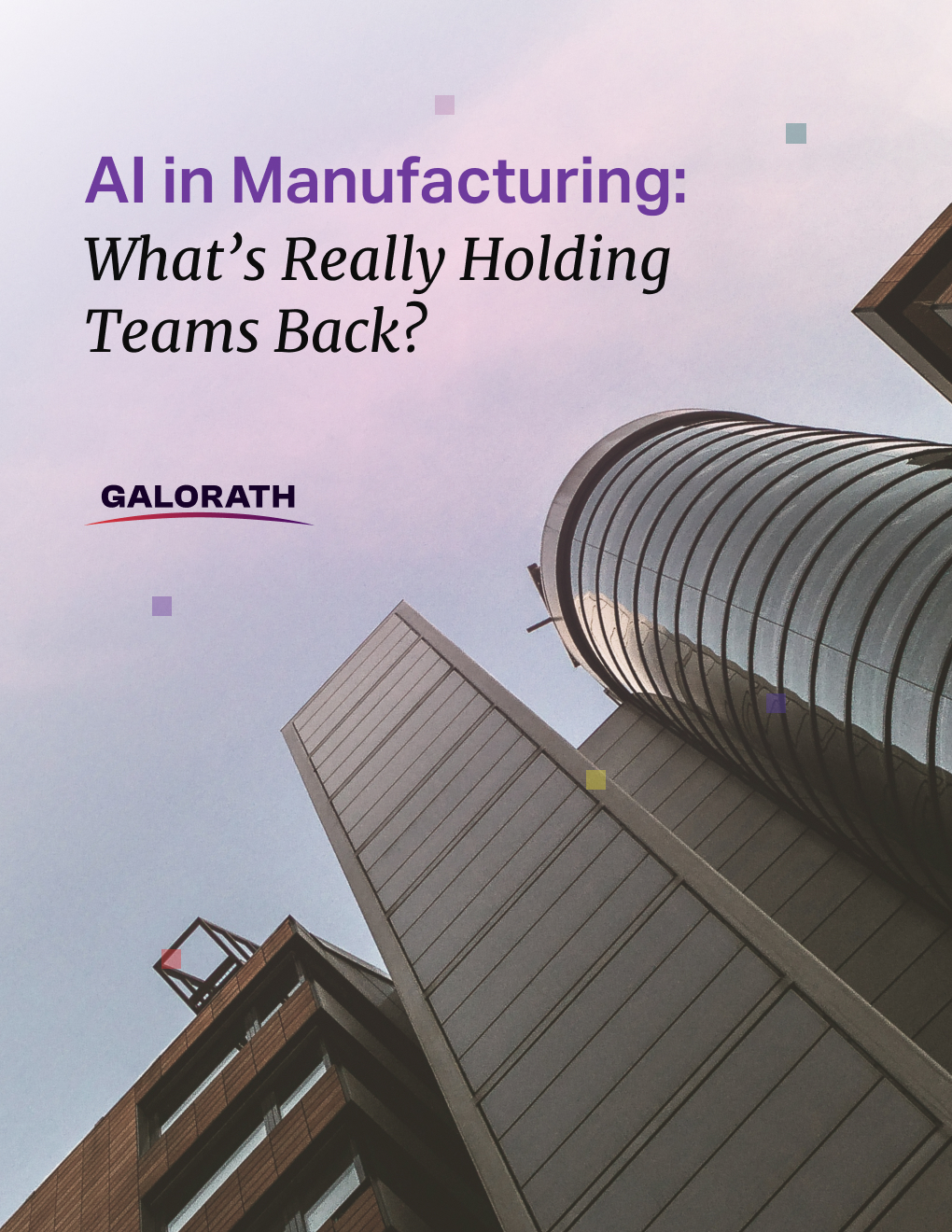Mastering Cost Risk with the CRED Model: A New Approach to Managing Uncertainty
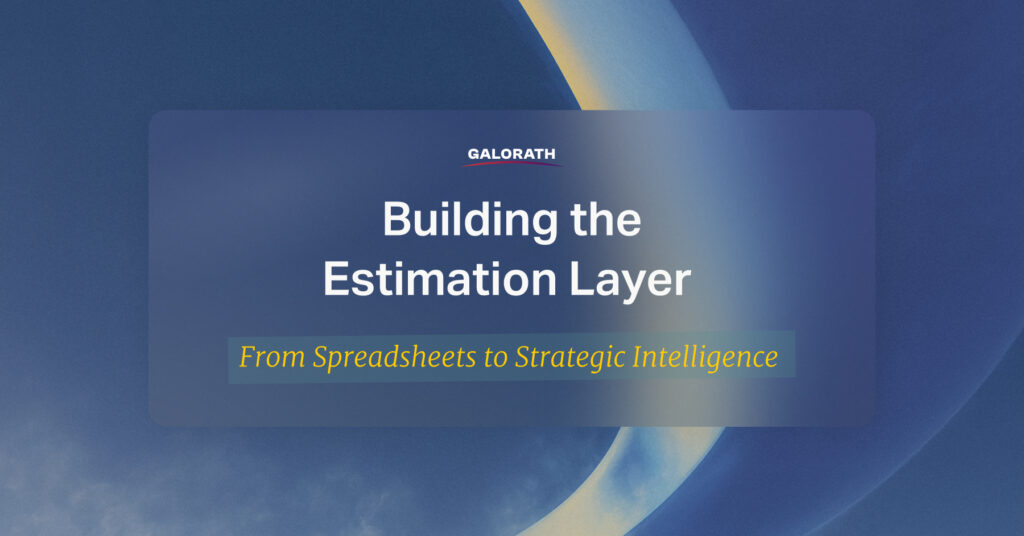
Table of Contents
Most enterprise tech stacks support execution. Project and cost estimation is still playing catch-up. To make better, faster, and more accountable decisions in 2025, organizations need a new layer in their infrastructure: one built specifically for cost, schedule, and risk planning.
Estimation has been left behind
Despite rapid advances in data infrastructure, AI enablement, and cross-functional platforms, estimation remains one of the least modernized functions in the enterprise. Most organizations still rely on spreadsheets and static templates to make decisions that directly affect budgets, timelines, and strategic alignment. The gap between operational speed and planning capability is growing and it’s quickly becoming a liability.
Estimation touches nearly every department. Whether teams are forecasting labor needs, selecting vendors, modeling logistics, or shaping go-to-market plans, they rely on inputs that must be current, explainable, and adaptable. When those inputs come from disconnected tools, untraceable models, or manual assumptions, every downstream decision becomes riskier.
Without a structured approach to estimation, organizations lose time to rework, struggle to justify proposals, and fall short of stakeholder expectations. What is missing is not more data or more technology. What is missing is structure. Estimation needs a dedicated layer, an integrated system that connects cost and risk analysis to the platforms where decisions are made.
What happens when estimation is isolated
When estimation is siloed, the effects ripple across the enterprise. Program managers build schedules that do not account for real labor constraints. Finance teams develop budgets on top of outdated inputs. Engineering, sourcing, and operations each work from separate assumptions, often without a shared source of truth.
The result is more than misalignment. It is friction. Delays increase. Confidence erodes. Leaders make decisions with less clarity and greater exposure. In some cases, it is not until late-stage reviews that teams realize their forecasts are flawed or incomplete, which forces rework and undermines trust in the process.
Disconnected estimation is not just a technical problem. It is an organizational one. When modeling is treated as a one-time task instead of a continuous input, estimation fails to reflect change, scale with complexity, or improve over time. That is why a modern enterprise cannot afford to treat estimation as an afterthought. It needs to be built into the architecture of planning itself.
What an estimation layer looks like
A dedicated estimation layer is not a single tool. It is a system of capabilities, processes, and data connections that support ongoing decision-making. It is structured, collaborative, and role aware. Most importantly, it integrates tightly with the rest of the enterprise stack.
A mature estimation layer includes version control for forecasts, allowing teams to track how assumptions evolve and how those changes affect outcomes. It provides embedded cost libraries and historical benchmarks so that estimators are not starting from scratch or relying on intuition. These models should support what-if analysis, enabling scenario testing without disrupting core planning workflows.
Equally important is the ability to feed outputs into downstream systems. Estimations should inform sourcing decisions, RFP responses, proposal development, and executive reporting. Outputs must be traceable back to inputs, and every assumption should be visible and auditable. Without these elements, estimation remains isolated and its value remains unrealized.
Visualizing the estimation shift
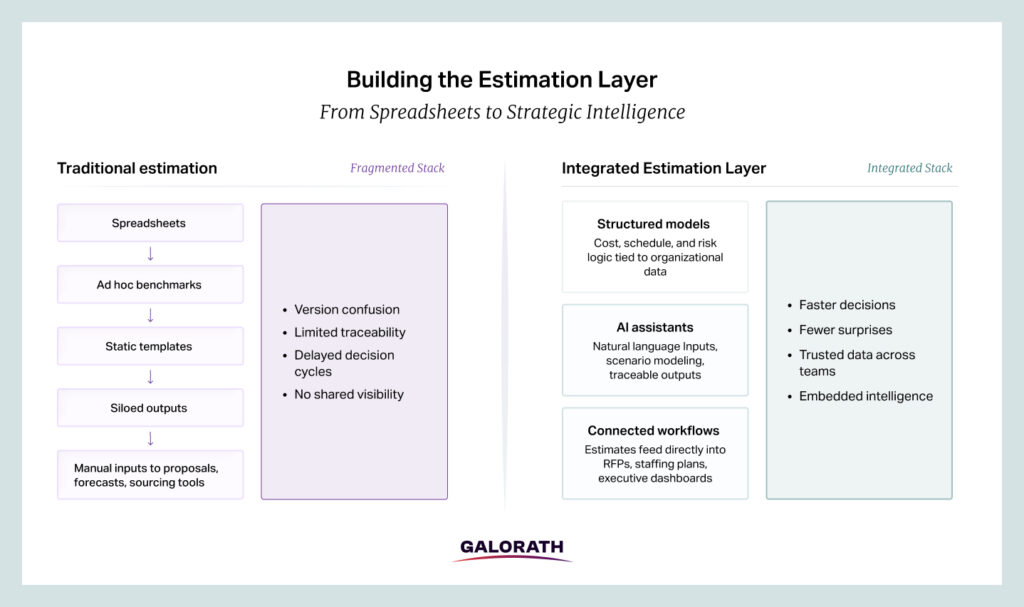
Why spreadsheets can’t do this
Spreadsheets have long been the default tool for estimation. They are flexible, familiar, and widely available. But they are not built for traceability, version management, or collaboration at scale. In 2025, their limitations are not just inconvenient; they’re operational risks.
In most spreadsheet-based workflows, changes are difficult to track. Different versions circulate across teams, often without clear authorship or context. Cross-functional collaboration becomes a copy-and-paste exercise, where misalignment is both common and costly. Spreadsheets also make it hard to apply consistent assumptions, which means the same scenario can generate wildly different outcomes depending on who is modeling it.
Beyond governance, spreadsheets are not equipped to model uncertainty, assess risk, or simulate scenarios. They lack the intelligence and structure needed to answer the complex questions that drive investment, resource allocation, and program planning. As estimation becomes more critical to enterprise agility, spreadsheets are no longer enough.
Estimation is not just a process. It’s a planning intelligence layer
Treating estimation as a back-office task limits its potential. At its best, estimation is not just a support function. It is a strategic layer of intelligence that influences how organizations invest, staff, and deliver. That layer must be built intentionally, with infrastructure that matches its importance.
When estimation is embedded as a layer, it enables trade-space analysis that helps teams make informed compromises between cost, capability, and time. It supports real-time adjustments when external factors shift. And it provides a transparent foundation for executive decision-making, board reviews, and oversight.
A modern estimation layer aligns engineering, finance, operations, and procurement around a shared understanding of what is possible, what it will cost, and what tradeoffs are required. This clarity enables faster decisions, better outcomes, and more efficient resource use. That is what makes it an asset, not just a workflow.
See the estimation layer in action: How Lockheed Martin scaled smart estimation
Modernizing estimation is not just theoretical. Organizations like Lockheed Martin have already built structured planning systems that improve speed, accuracy, and efficiency across teams.
Lockheed Martin’s analysts spent up to a week generating cost estimates for complex manufacturing programs. By implementing Galorath’s SEER platform as part of a broader estimation modernization effort, the team reduced delivery time from seven days to two. The shift saved up to 400 hours per month across proposals, trade studies, and engineering change requests.
This was not just about faster modeling. Lockheed’s use of SEER brought consistent logic, embedded cost baselines, and shared outputs to multiple teams. The estimation layer they built enabled better sourcing decisions and more credible proposals, without adding headcount.
Read the full Lockheed Martin case study →
From insight to action: A checklist for building your estimation layer
Estimation modernization does not require a full system overhaul, but it does require structure. Use this checklist to assess readiness, identify priorities, and begin laying the foundation for an integrated estimation layer that supports real-time planning and long-term confidence.
Checklist:
- Audit your current estimation landscape
- Map integration points across departments
- Evaluate version control and traceability
- Prioritize explainable AI and parametric logic
- Align engineering, finance, and program stakeholders
- Plan for adoption, not just deployment
Download the full checklist →
Estimation cannot be the weak link
As organizations move faster and face higher demands for accountability, planning must be as modern as the systems it supports. Estimation cannot remain fragmented. It must be structured, explainable, and integrated into how decisions are made across the enterprise.
The estimation layer is not a luxury. It is a necessity. It provides the speed, clarity, and confidence needed to navigate complexity, manage tradeoffs, and drive outcomes that matter. Organizations that invest in this layer will move faster, respond smarter, and plan with greater confidence than those still relying on spreadsheets.
Galorath is helping enterprises make that shift, not just by improving tools, but by changing what planning can do.
10-Step Estimation Process Checklist
View our 10 Step Estimating Process Checklist. This checklist should be tuned to the individual company’s needs and suggestions.
Estimating Total Cost of Ownership (TCO)
Find out how you can use Total Cost of Ownership (TCO) model to create an estimate which includes all the costs generated over the useful life of a given application.
Should Cost Analysis
Learn how Should-Cost Analysis can identify savings opportunities and drive cost efficiency in procurement and manufacturing processes.
ROM Estimate: The First Step Towards a Detailed Project Plan
Find out what ROM (rough order of magnitude) estimate is and why is it a crucial element of every project planning cycle.
Software Maintenance Cost
Find out why accurate estimation of software maintenance costs is critical to proper project management, and how it can make up to roughly 75% of the TCO.

